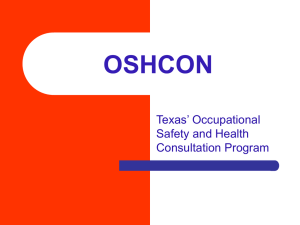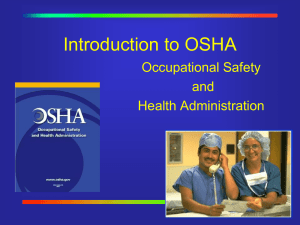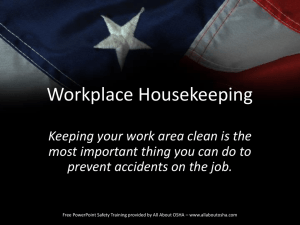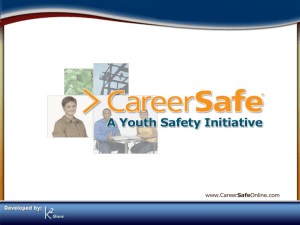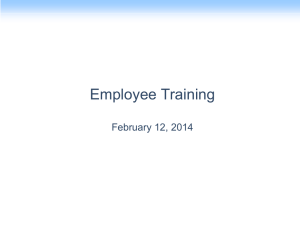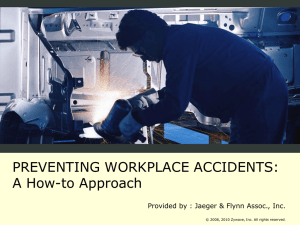OSHA Healthcare-Related Regulations
advertisement
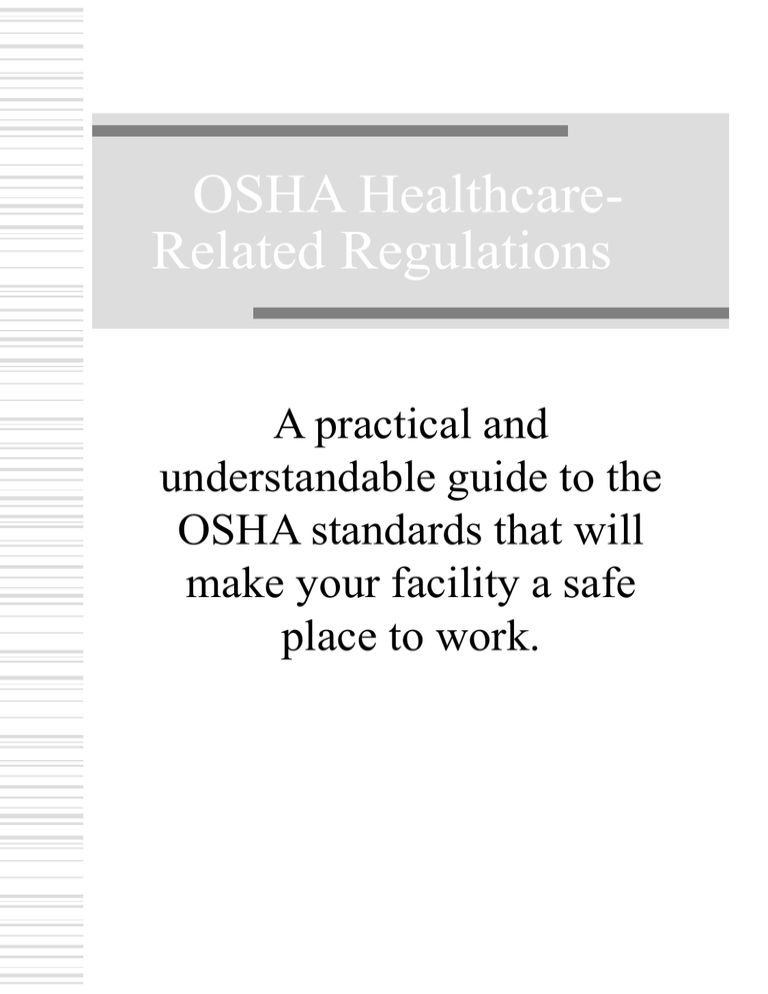
OSHA HealthcareRelated Regulations A practical and understandable guide to the OSHA standards that will make your facility a safe place to work. OSHA’s Hospital eTool The OSH Act of 1970 strives to “assure safe and healthful working conditions” for today’s workers, and mandates that employers provide a safe work environment for employees. Hospitals and personal care facilities employ approximately 1.6 million workers at 21,000 work sites. There are many occupational health and safety hazards throughout the hospital. This eTool focuses on some of the hazards and controls found in the hospital setting, and describes standard requirements as well as recommended safe work practices for employee safety and health. OSHA’s Hospital eTool The OSHA Hospital e-Tool is a stand alone, interactive, Web-based training tool on occupational safety and health topics. They are highly illustrated and utilize graphical menus as well as expert system modules. These modules enable the user to answer questions and receive reliable advice on how OSHA regulations apply to their work site. These e-Tools do not create new OSHA requirements. OSHA’s Hospital eTool This eTool addresses the following areas: • Administration • ICU • Central Supply • Laboratories • Clinical Areas • Dietary • Emergency • Engineering • Heliport • Housekeeping • Laundry • Laboratories Laundry • Surgical Suite Healthcare Wide Hazards Other Healthcare Wide OSHA’s Hospital eTool Healthcare Wide Hazards • Bloodborne Pathogens 1. Exposure Control Plan 2. HIV, HBV, HCV • Electrical • Ergonomics • Fire Hazards • Hazardous Chemicals • Infection-MRSA, VRE, SARS, etc. OSHA’s Hospital eTool Healthcare Wide Hazards (continued) •Needlesticks •Mercury Spills •Slips/Trips/Falls •Contaminated Work Environments OSHA’s Hospital eTool Housekeeping/Utility Module •Appropriate Disinfectants •Contaminated Equipment •Sharps and Containers •Hazardous Chemicals •Latex Allergy •Slips/Trips/Falls •Asbestos in Flooring OSHA’s Hospital eTool Housekeeping and Asbestos: All surfaces must be maintained as free as possible of accumulations of waste containing asbestos and/or asbestos dust. The preferred methods of cleanup are wet cleaning and/or vacuuming with HEPA filtered vacuuming equipment. Sanding of asbestos containing floors (Floor tiles installed before 1980 most likely contain asbestos) is prohibited. Low abrasion pads at speeds lower than 300 rpm and wet methods must be used. If floor has sufficient finish, brushing or dry buffing is permissible. If workers are required to buff or wax asbestos containing resilient floors, building and facility owners must identify the installed material and inform employees and employers of outside contractors doing such work. OSHA’s Hospital eTool Floors-To Disinfect or Not to Disinfect…CDC says, “Extraordinary cleaning and decontamination of floors in healthcare settings is unwarranted. Studies have demonstrated that disinfection of floors offers no advantage over regular detergent/water cleaning and has minimal or no impact on the occurrence of healthcare-associated infections. Additionally, newly cleaned floors become rapidly recontaminated from airborne microorganisms and those transferred from shoes, equipment wheels and body substances. Nevertheless, healthcare institutions may choose an EPA-registered detergent/disinfectant for cleaning low-touch surfaces (e.g., floors) in patient care areas because of the difficulty that personnel may have in determining if a spill contains blood or body fluids (requiring a disinfection for cleanup) or when a multi-drug resistant organism is likely to be in the environment.” OSHA’s Hospital eTool OSHA's National Office sent a memorandum to its field offices on November 1, 1996 regarding inquiries from companies who manufactured and/or supplied product(s) approved by the EPA as effective against HBV and HIV. They inquired if the new EPA registered products with the new EPA label would be an "appropriate disinfectant" under OSHA's Bloodborne Pathogen Standard, 29 CFR 1910.1030. This memo stated the products could be used under limited conditions, specifically where HIV and HBV were the only pathogens of concern (for example, in a research setting). Mr. Bach referred to this memorandum in his article, "Disinfection Efficacy Against Micobacterium tuberculosis and the OSHA Bloodborne Pathogens Standard", in the April 1999 issue of your Infection Control Today magazine. Unfortunately, this memorandum was superseded in 1997 and no longer reflects OSHA's current policy on the use of disinfectants with an EPAapproval against HBV/HIV. OSHA’s Hospital eTool OSHA MEMORANDUM-CONTINUED OSHA reconsidered the limitations in the memorandum of November 1, 1996 and issued a revision on February 28, 1997. We decided that the policy requiring the use of EPAregistered tuberculocidal disinfectants and\or a diluted bleach solution to decontaminate contaminated work surfaces should be expanded to include EPA-registered disinfectants that are effective against both HIV and HBV. OSHA's current policy is that EPAregistered disinfectants for HIV and HBV meet the requirement in the bloodborne pathogen standard and are "appropriate" disinfectants to clean contaminated surfaces, provided such surfaces have not become contaminated with agent(s), volumes, or concentrations of agent(s) for which higher level disinfection is recommended. OSHA Regulations General Duty Clause Section 5(a)(1) of the OSH Act requires that “Each employer shall furnish to each of his employees employment and a place of employment which are free from recognized hazards that are causing or are likely to cause death or serious physical harm to his employees.” OSHA Regulations General Duty Clause (continued) Four elements are required for issuing General Duty Clause violations: 1. The employer failed to keep the workplace free of a hazard to which employees of that employer were exposed. 2. The hazard was recognized. 3. The hazard was causing or was likely to cause death or serious physical harm. 4. There was a feasible and useful method to correct the hazard. OSHA Regulations General Duty Clause (continued) The General Duty Clause is used only where there is no OSHA standard that applies to the particular hazard involved. Examples of Housekeeping-related workplace hazards to which the General Duty Clause may apply include: •Aerosolizing disinfectants, bleach, or other products which may cause shortness of breath (acute) or respiratory illness (chronic). •Housekeepers who wear exam gloves to do routine chemical disinfection or surface cleaning. OSHA Regulations The Exposure Control Plan shall contain at least the following elements: The exposure determination required by paragraph Regulated Waste means liquid or semiliquid blood or other potentially infectious materials; contaminated items that would release blood or other potentially infectious materials in a liquid or semi-liquid state if compressed; items that are caked with dried blood or other potentially infectious materials and are capable of releasing these materials during handling; contaminated sharps; and pathological and microbiological wastes containing blood or other potentially infectious materials. OSHA Regulations The Exposure Control Plan shall be reviewed and updated at least annually and whenever necessary to reflect new or modified tasks and procedures which affect occupational exposure and to reflect new or revised employee positions with occupational exposure. The review and update of such plans shall also: Reflect changes in technology that eliminate or reduce exposure to bloodborne pathogens; and Document annually consideration and implementation of appropriate commercially available and effective safer medical devices designed to eliminate or minimize occupational exposure. OSHA Regulations Other Potentially Infectious Materials means (1) The following human body fluids: semen, vaginal secretions, cerebrospinal fluid, synovial fluid, pleural fluid, pericardial fluid, peritoneal fluid, amniotic fluid, saliva in dental procedures, any body fluid that is visibly contaminated with blood, and all body fluids in situations where it is difficult or impossible to differentiate between body fluids; (2) Any unfixed tissue or organ (other than intact skin) from a human (living or dead); and (3) HIV-containing cell or tissue cultures, organ cultures, and HIV- or HBVcontaining culture medium or other solutions; and blood, organs, or other tissues from experimental animals infected with HIV or HBV. Recommendations Regarding the Spraying of Chemicals It is recommended that chemical agents or germicidal detergents not be used in a mist or spray operation. Any chemical agent,if inhaled over a long period of time, has the potential of being detrimental to some individuals. In general, the desired results can be achieved by applying a stream of liquid to a mirror, over-bed table, drinking fountains or similar surfaces; or it can be applied in a stream to a cleaning cloth which is then used to clean these surfaces. Spraying chemicals in the air has the potential for down-side risk not only to the user of the product but to patients who might have breathing difficulties or other problems. These products should not be aerosolized in a healthcare environment. Some chemical labels indicate that the product should not be sprayed in a mist. Read your labels. Recommendations for Utility Gloves In Place of Exam Gloves It is recommended that the manufacturer of the glove worn by Housekeepers using chemicals (especially disinfectants) be asked to provide a letter to place in your file. This letter should state that the glove will protect the Housekeeper’s hands from chemicals for up to 6 hours per day. If the manufacturer won’t provide a letter to protect you, your hospital and your workers, you need to find one who will. Consider using a Nitrile Utility Glove. Most manufacturers will certify, in writing – No absorption, No strikethrough for 6-8 hours. Sell your staff that these gloves will provide chemical protection and that failure to wear them could lead to disciplinary action up to and including discharge.


